Pork Adobo is made with succulent pork belly braised in vinegar, soy sauce, garlic, and onions. A delicious balance of salty and savory, this hearty stew is the Philippines' national dish for a good reason!
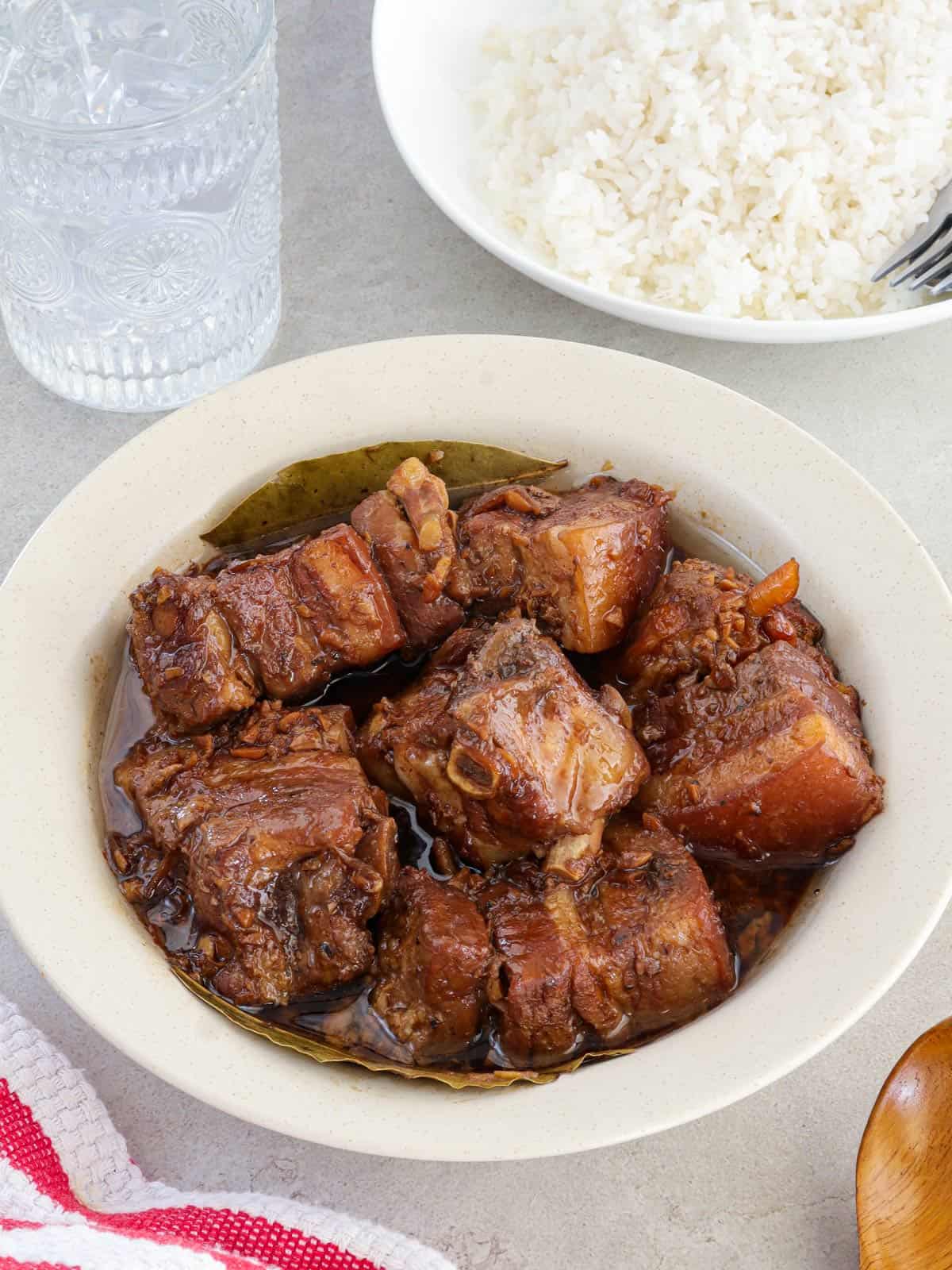
The Filipino adobo is a cooking process or technique in which meat, seafood, or indigenous vegetables are braised in a mixture of vinegar and aromatics such as garlic, onions, peppercorns, and bay leaves.
The many ways adobo is prepared are as diverse as the islands and dialects in the Philippines. Adobong pula with atsuete, Adobo sa gata, and Pineapple Pork Adobo are just a few versions of this classic Filipino national dish.
Some like the hearty stew with more sauce, while others prefer it simmered dry. Others like it slightly tangy, while some prefer it on the sweet side. This recipe is how I like mine, with beautifully seared pork and a rich and thick sauce to spoon over mounds of rice.
More adobo recipes to try
Ingredient notes
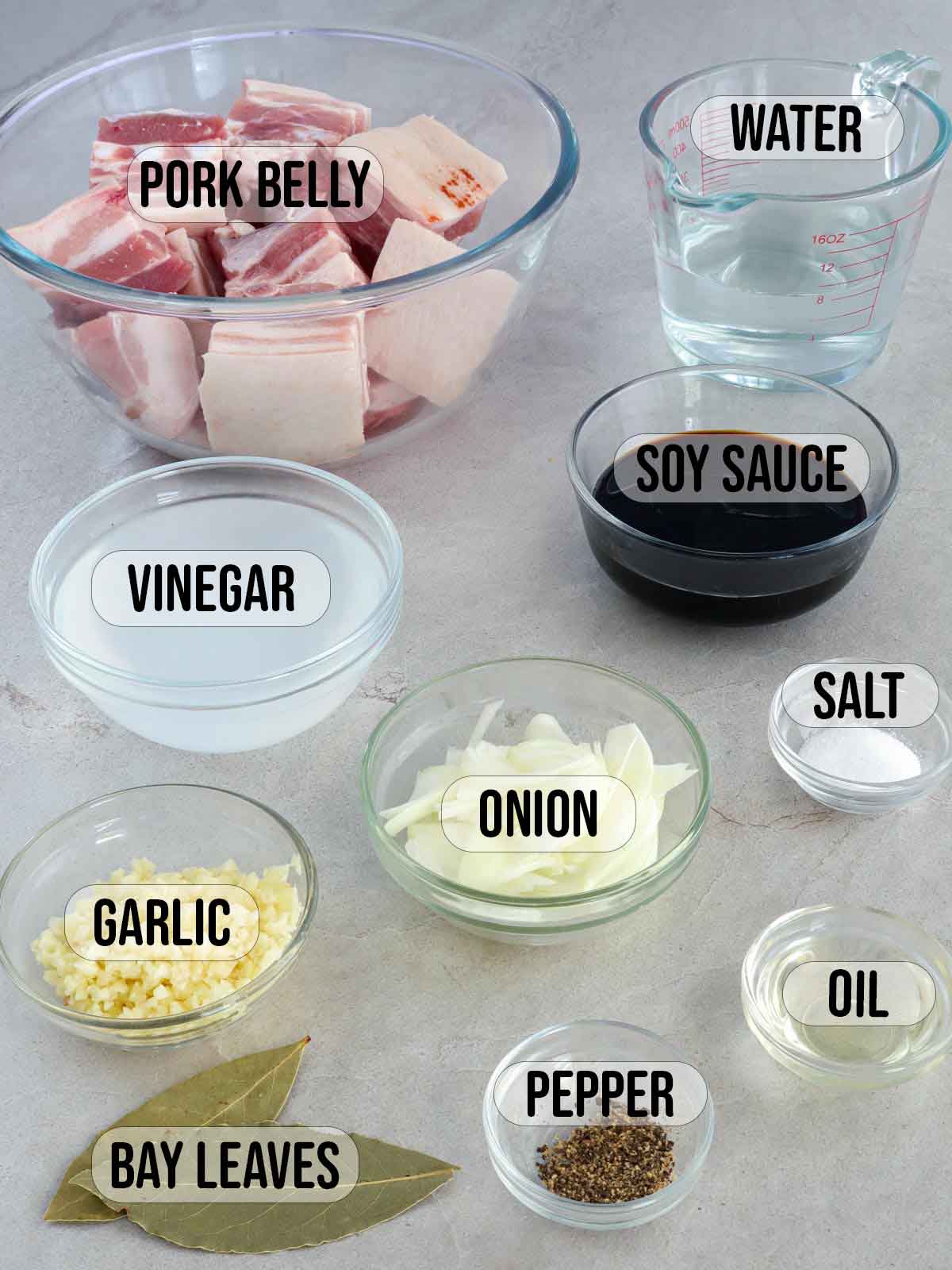
- Pork- I prefer to use pork belly in my adobo because I like its melt-in-your-mouth tenderness, but you can substitute pork shoulder, which, although a leaner cut, has enough ribbons of fat to bring equally delicious results. Other cuts, such as pork chops, legs, hocks, and ribs, are also good options for slow cooking.
- Oil- for sauteing and browning
- Sauce- a classic combination of tangy vinegar and savory soy sauce; water for tenderizing the meat.
- Aromatics- garlic, onion, bay leaves, and peppercorns enhance flavor.
- Seasonings- adjust taste with salt and pepper
Pork Adobo cooking steps
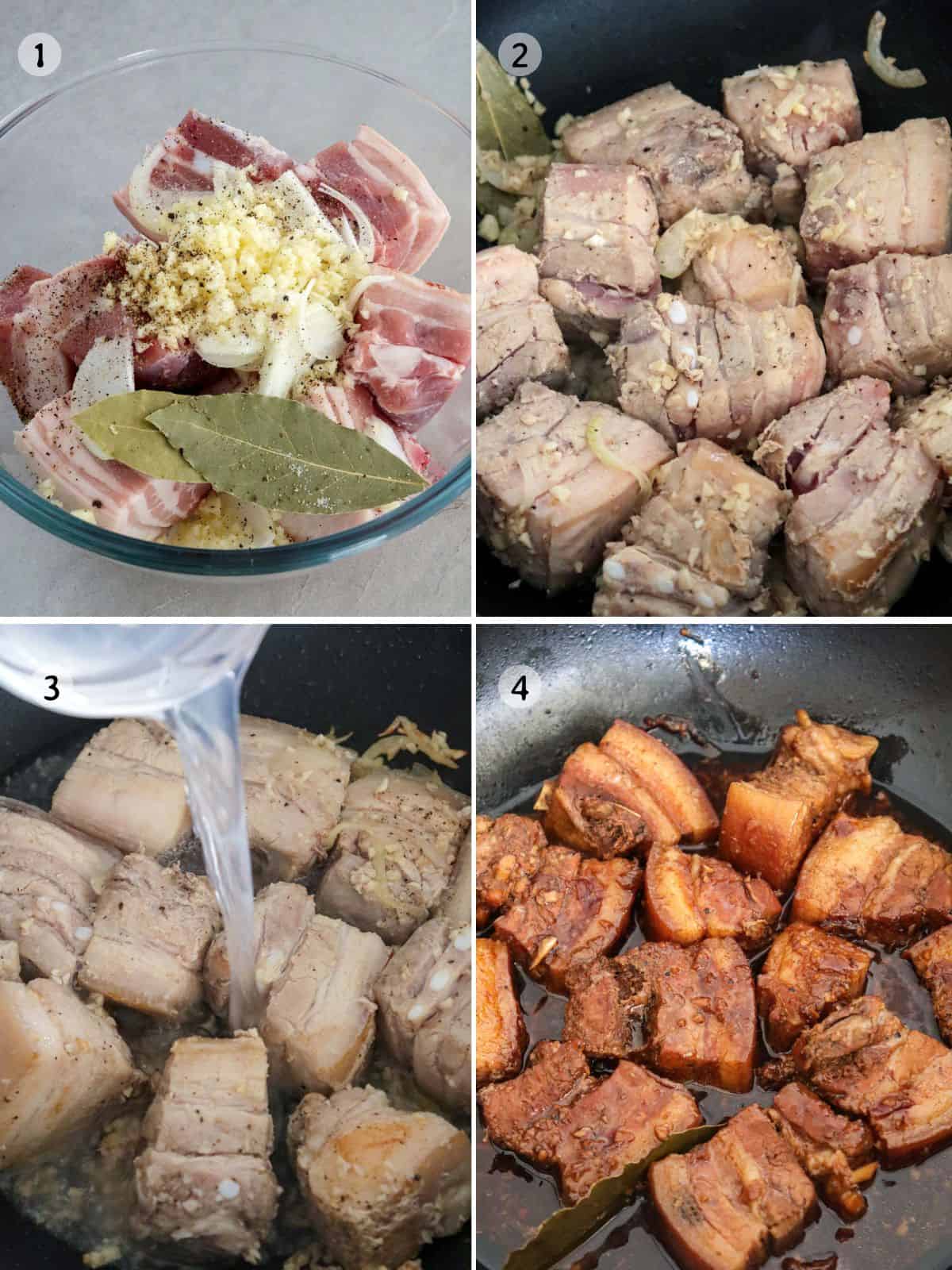
- Marinate- Cut the meat into uniform pieces to ensure even cooking. Combine with onions, garlic, bay leaves, salt, and pepper in a bowl. Marinate in the refrigerator for about 30 minutes.
- Brown the pork - Heat oil in a wide, heavy-bottomed skillet over medium heat. Add the meat mixture and cook, turning occasionally, until the pork is lightly browned. Do not overcrowd the pan when browning the pork so it gets a good sear and does not steam. Use a wide pan or cook in batches if necessary. Properly searing the meat before adding the braising liquid is an important step, as it gives the dish a delicious color and incredible depth of flavor.
- Add vinegar and allow it to boil, uncovered, without stirring to cook off the strong acid taste.
- Cook- Add soy sauce and water and stir to combine. Bring to a boil. Lower the heat, cover, and simmer until the meat is fork-tender and the sauce is reduced. Season with salt and pepper to taste.
Cooking tips
- Potatoes and hard-boiled eggs are a delicious way to extend servings. To help the potatoes from falling apart, pan-fry the cut potatoes first before adding them to the stew.
- If you want to season the dish with more salt than the recipe calls for, I suggest adding it during the last few minutes of cooking to gauge taste correctly. The flavor of the dish will concentrate as the sauce reduces.
Serving suggestions
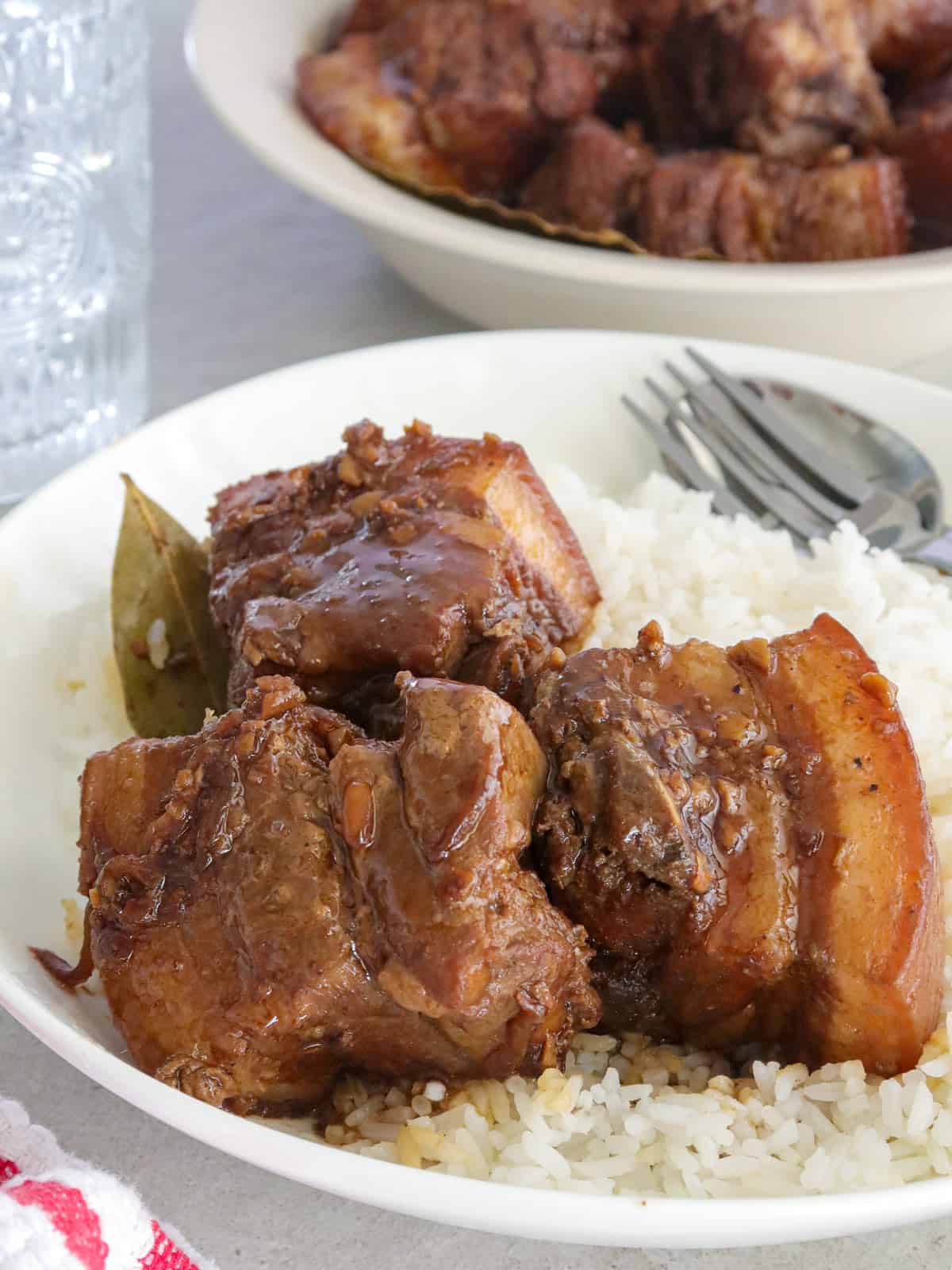
- Adobong baboy is best enjoyed with piping hot steamed rice for lunch or dinner. It's common to find it on breakfast menus, such as an adosilog meal (adobo, garlic fried rice, and fried egg).
- While it is mainly served as a viand, adobo meat is also used as a filling for bread, such as siopao or pandesal.
Storing leftovers
The adobo cooking process was initially a way to preserve food. Pre-colonial Filipinos prepared meat and seafood in vinegar and salt to prolong shelf life. It's a great make-ahead dish that tastes better after a day or two when the flavors have melded.
- Cool completely before transferring to a container with a tight-fitting lid. Refrigerate for up to 3 days or freeze for up to 2 months.
- Reheat in a wide pan over low heat to an internal temperature of 165 F or in the microwave at 2 to 3-minute intervals until completely heated.
- Leftovers can also be turned into delicious fried rice. Shred the cooked meat and toss with day-old steamed rice in a hot pan along with a few tablespoons of the sauce.
More pork recipes
Ingredients
- 2 pounds pork belly, cut into 2-inch cubes
- 1 onion, peeled and sliced thinly
- 1 head garlic, peeled and minced
- 2 bay leaves
- 1 teaspoon salt
- ½ teaspoon pepper
- 1 tablespoon oil
- 1 cup vinegar
- ½ cup soy sauce
- 1 cup water
Instructions
- In a bowl, combine pork, onions, garlic, bay leaves, salt, and pepper. Place in the refrigerator and marinate for about 30 minutes.
- In a wide, heavy-bottomed skillet over medium heat, heat oil. Add meat mixture and cook, turning occasionally, until pork is lightly browned.
- Add vinegar and allow to boil, uncovered and without stirring, for about 3 to 5 minutes.
- Add soy sauce and water and stir to combine. Allow to a boil for another 3 to 5 minutes.
- Lower heat, cover, and simmer for about 40 to 50 minutes or until meat is fork-tender and sauce is reduced.
- Season with salt and pepper to taste. Serve hot.
Notes
- Cook off the strong vinegar flavor by allowing it to boil uncovered and without stirring for a good few minutes before adding the soy sauce and water.
- If you want to season the dish with more salt than called for in the recipe, I suggest adding it during the last few minutes of cooking to correctly gauge taste. The flavor of the dish will concentrate as the sauce reduces.
Nutrition Information
“This website provides approximate nutrition information for convenience and as a courtesy only. Nutrition data is gathered primarily from the USDA Food Composition Database, whenever available, or otherwise other online calculators.”

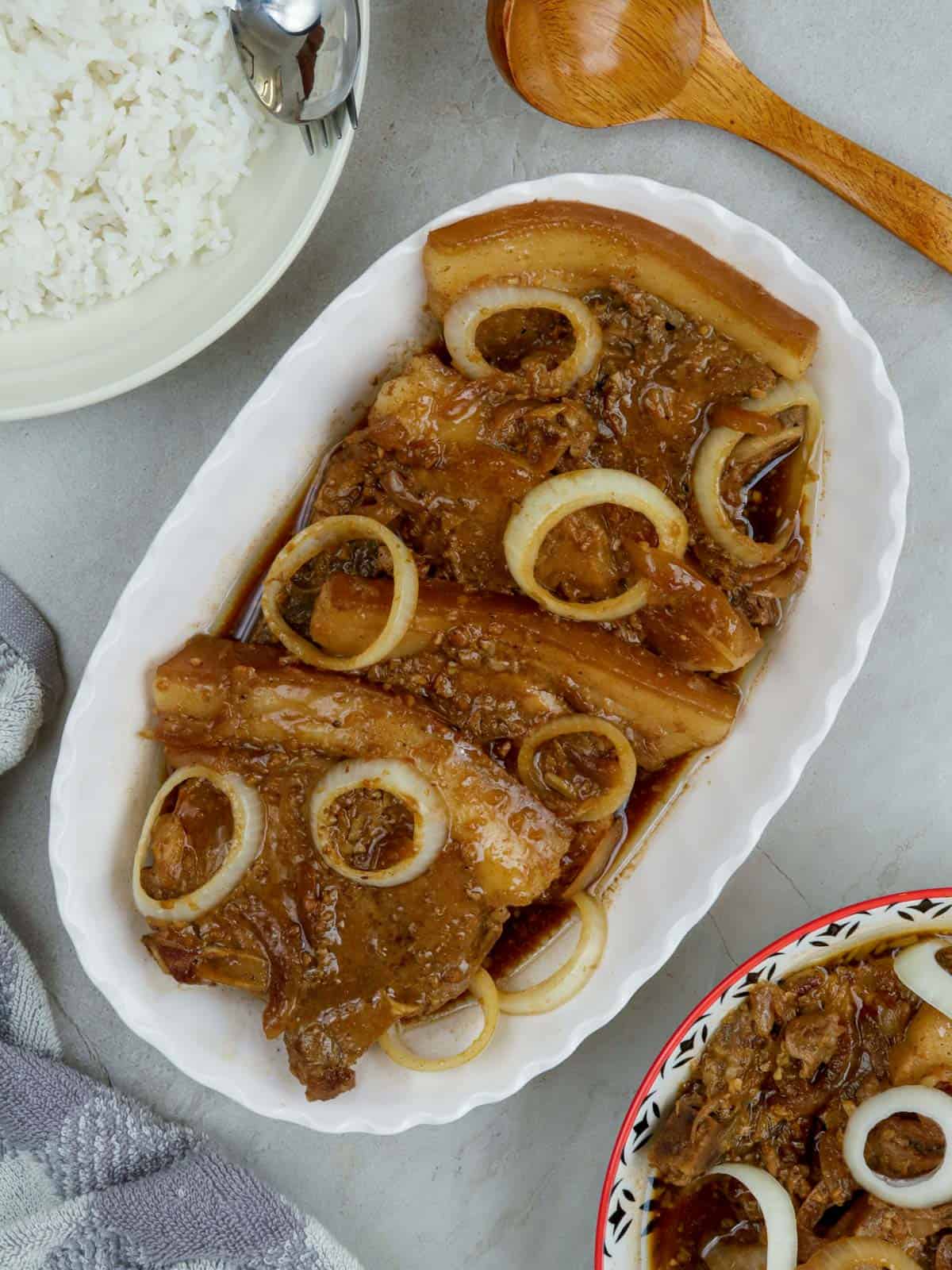
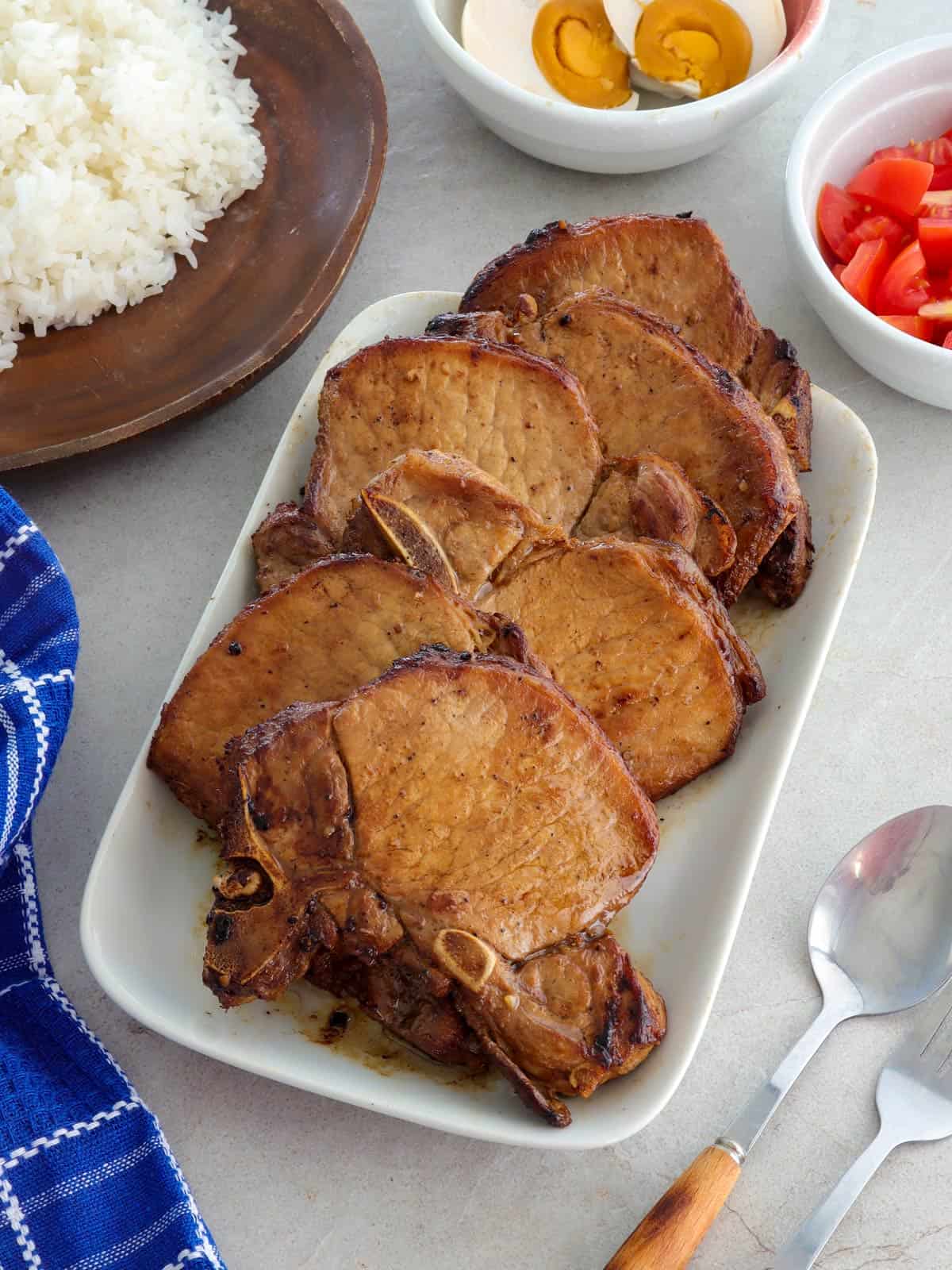


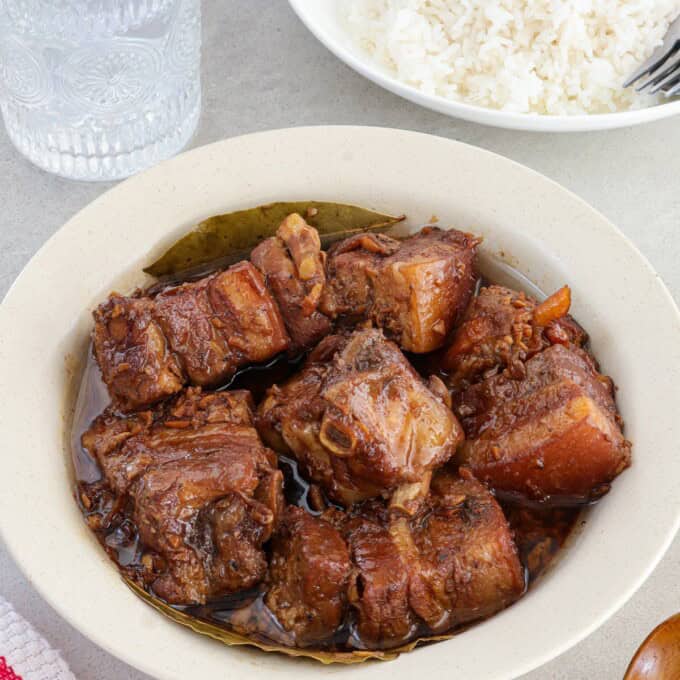

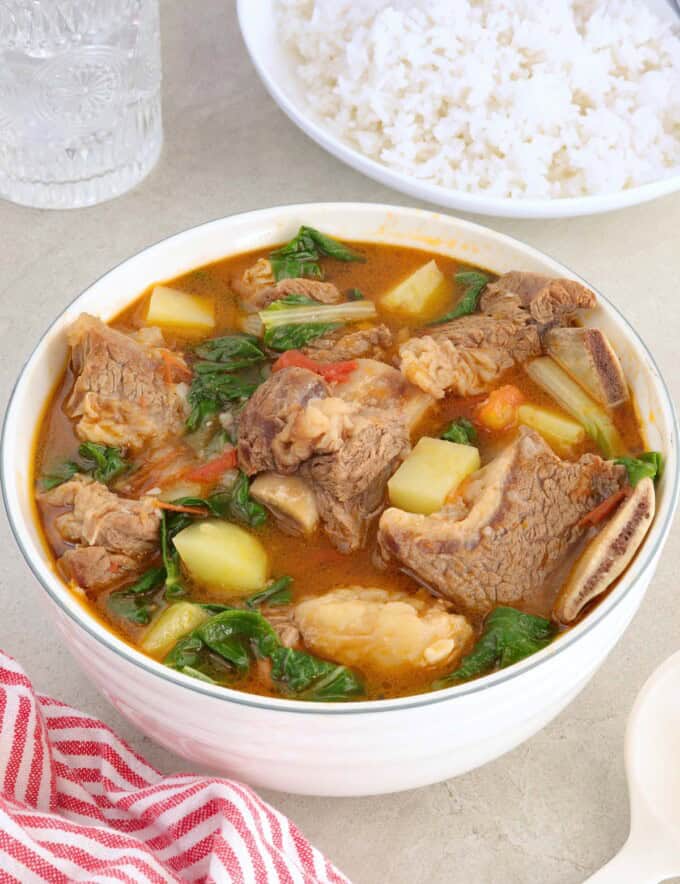
Ritchil Shafer says
Did you use ground pepper?
Lalaine Manalo says
Yes, I did 🙂
John Smith says
Very salty
oliver says
1 cup of vinegar is way too much
Lalaine Manalo says
I cup or 8 ounces is just enough for the amount of meat used in the recipe. Of course, you can decrease the amount according to your taste.
Kaitlyn says
This instantly became one of my favourite meals! I've had pork adobo before at a takeaway place, and with the addition of a couple of potatoes this recipe is just as rich and delicious.
Only change I made was to half the water to 1/2 cup (or even a little less). It still takes a full hour to thicken up for me. Also Datu Puti vinegar is delicious and fruity compared to distilled vinegar. I think it was well worth seeking out for this recipe.
Lalaine Manalo says
Glad you liked it! I agree about Datu Puti being worth the search! Have you tried our Chicken Adobo?
Deria Meneses says
I made this. I added kecap manis and honey to make it a bit sweeter. Also added boiled egg and potatoes.
Lalaine Manalo says
Thanks for the tip; I love sweet adobo and the use of kecap manis and honey is brilliant 🙂
Marcie V. says
I always use the datu puti white vinegar and Marca pina soy sauce. Makes the best flavor for adobo or pancit! Very authentic! I pretty much followed the ingredients exactly, except I used a tablespoon on peppercorns instead of ground pepper. I also didn’t marinate my pork and turned out perfectly!! Cooked mine a tad longer because I wanted the meat more tender! Will definitely make this again, and again 😁😁
Lalaine Manalo says
Hi Marcie! That's basically me. I make this dish again and again 🙂
Alex Saunders says
hi , I love cooking all sorts of foods and especially oriental , I just would like to understand your recipes a little better , like 1/2 teaspoon of pepper would that be black or white pepper , ground or cloves.
And I often use garlic paste than fresh garlic, so an idea of the paste amount would help ,
I know you cannot cater for every eventuality but a little thought for those less experienced or just unsure will make your excellent recipes more enjoyable to a wider audience. please keep up the good work.
Lalaine Manalo says
Thanks, Alex. I'll try to be more specific and add as much information as I can.
Paul says
I would mention in your recipe to use either rice or sugar cane vinegar. Those using distilled white vinegar will have an over powering harsh adobo even with cooking it off before hand. Your adobo recipe is great with the correct vinegar.
Thanks.
Lalaine Manalo says
Thanks for the feedback. Yes, the type of vinegar does contribute to the overall taste of the dish.
Gina says
I also use this recipe for adobo and my family
loves it! I brought it to a potluck and my friends loved it too! Thank you!!
Can I use a slow cooker to finish cooking this adobo and if so, can I have instructions? Thank you.
Lalaine Manalo says
Thank you, Gina. I am glad the family loved it. Yes, you can make adobo in a slow cooker. Sear the meat in skillet and transfer to the crockpot along with the other ingredients. Cook on low for about 6 hours or on high for about 4 hours or until tender. When meat is just about tender, remove the lid and simmer to reduce the liquid and cook off the acid taste. You might have to decrease the amount of liquid as the slow cooker doesn't allow too much evaporation.
Mike A says
Should have read the comments first...used red wine vinegar and it’s not bad, but not quite right either. Next time I’ll try Datu Puti if I can find it, or generic white vinegar.
Lalaine Manalo says
Hi Mike! Hope you got your hands on some Datu Puti!
Lay says
Hi Im planning to follow this recipe and use 3kg of pork. If i follow the ratio, that would call for 3 cups of vinegar. Would it be safe to use use 3cups vinegar? Im afraid it might end up sour...
Lalaine Manalo says
Increase the liquids but not necessarily triple the amount.
Kimmy says
You got me at boil off the vinegar. Best adobo recipe by far. Somehow I managed to cook a "perfect" (for me) Adobo. Thanks very much!!!
Lalaine says
Thank you for the feedback, Kimmy. Yes, boiling the vinegar really makes a difference in taste 🙂
Sharky says
Thank you so much! I've tried so many adobo recipes and I could never find one that I liked. Tried this and this is a winner! I used to always had to add sugar to make my adobo yummy. Also, I never knew you need to uncover the pot to lessen the acidity of the suka! Even my foreign hubby loved it (he never showed this much enthusiasm with my previous adobos) and even requested for me to make this with chicken. Thanks!
Lalaine says
Yes, cooking off the vinegar really makes a big difference in the outcome. Thanks for the feedback, I am glad the hubby enjoyed it. 🙂
Doris Frutos says
Hi!I read all the comments and had to try it out for myself.I must say that I have tried other adobos but this one is a keeper.I used a rack of pork ribs and it turned out great.Thank you for the recipe Lalaine.
Lalaine says
Thanks, Doris. I love pork ribs in adobo; going through the bones to get to the meat makes the dish more enjoyable 🙂
Myla de Geron says
Hi Mam, this is the best recipe of adobo that ive tried! What if I want to cook 2 kilos or 3 kilos of pork, do i just need to multiply the ingredients to 2 or 3?
Lalaine Manalo says
Aww, thank you so much. You made my day. You can increase the amount of liquid but not necessarily double or triple. Just follow the ratio of vinegar, soy sauce, and water when adjusting the recipe.
Lorraine says
I tried this recipe and it was my first time to cook it but unfortunately it doesn't came out good and tasty. I followed the instructions very well but it doesn't taste that good.
Lalaine says
I'm sorry to hear the recipe didn't turn out as you like. May I know what it was lacking in taste?
papermoon says
Thank you! I made your tinola and adobo, brought back poignant memories growing up poor in the Philippines. The liver narrative on your tinola recipe made me choke back tears. Your pain was palpable. You’re not just a good rockstar but an astounding story teller. Love and peace from NJ, USA.
Lalaine says
Thank you so much! Sometimes, I wonder if I'm sharing too much of my life here on the blog but I did start it years ago as some kind of online journal. 🙂
Papermoon says
Hi again, Lalaine! I meant food rockstar 💋 thank you again for your astounding recipes, they are genuine and intimate and all a collective sentiment, bringing us all together. Tomorrow will be a dandy day, I’m making your eggplant torta. Its incredible simplicity is what makes it yummy and on point. Best wishes!
Lalaine Manalo says
Your comments mean so much to us! Let us know how the Tortang Talong turns out.